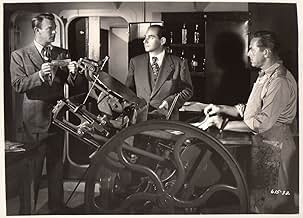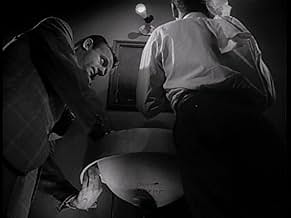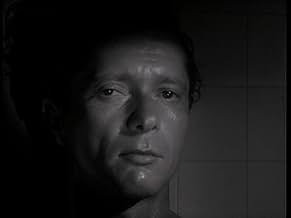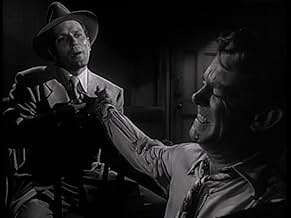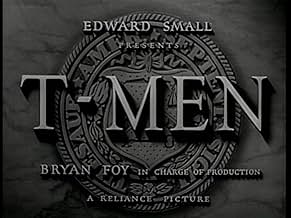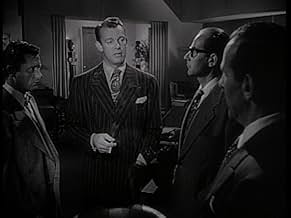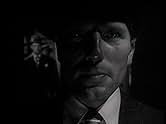IMDb RATING
6.9/10
4.1K
YOUR RATING
Two U.S. Treasury agents hunt a successful counterfeiting ring.Two U.S. Treasury agents hunt a successful counterfeiting ring.Two U.S. Treasury agents hunt a successful counterfeiting ring.
- Director
- Writers
- Stars
- Nominated for 1 Oscar
- 1 nomination total
Wallace Ford
- The Schemer
- (as Wally Ford)
Charles McGraw
- Moxie
- (as Charles Mc Graw)
John Ardell
- Dice Player
- (uncredited)
Vivian Austin
- Genevieve
- (uncredited)
Louis Bacigalupi
- Boxcar
- (uncredited)
Trevor Bardette
- Rudy
- (uncredited)
Salvadore Barroga
- Housekeeper
- (uncredited)
- Director
- Writers
- All cast & crew
- Production, box office & more at IMDbPro
Featured reviews
Some nice shadowy photography by John Alton and a well-paced storyline directed with style by Anthony Mann, makes for a diverting crime melodrama in crisp documentary style that was popular in the early to mid-'40s. Think BOOMERANG, THE HOUSE ON 92nd STREET, 13 ROUE MADELEINE and other Fox melodramas of that era.
But this was done on a poverty row budget by Eagle-Lion with the usually light-weight actor DENNIS O'KEEFE in the sort of role usually handed to someone like Dana Andrews, Mark Stevens, John Hodiak or William Eythe if the film was made at Fox.
He's surprisingly good as a noir hero whose task is to infiltrate a counterfeit gang with another Federal man, posing as would-be counterfeiters, and thus providing a succession of suspenseful moments where our hero is in danger of being exposed as a T-man for the government. Even more effective, in lesser roles, are CHARLES McGRAW and WALLACE FORD. In fact, McGraw would have been an even better choice for the lead than O'Keefe, his tight-lipped bearing and impressive physique suiting him for the role of a dangerous noir hero.
June Lockhart has only a fleeting appearance in one brief scene but others in the cast are properly sinister or authoritative, according to the way the script depicts the supporting characters.
Summing up: Worth a look, but not at the top of the film noir greats due to a script that is only slightly above average.
But this was done on a poverty row budget by Eagle-Lion with the usually light-weight actor DENNIS O'KEEFE in the sort of role usually handed to someone like Dana Andrews, Mark Stevens, John Hodiak or William Eythe if the film was made at Fox.
He's surprisingly good as a noir hero whose task is to infiltrate a counterfeit gang with another Federal man, posing as would-be counterfeiters, and thus providing a succession of suspenseful moments where our hero is in danger of being exposed as a T-man for the government. Even more effective, in lesser roles, are CHARLES McGRAW and WALLACE FORD. In fact, McGraw would have been an even better choice for the lead than O'Keefe, his tight-lipped bearing and impressive physique suiting him for the role of a dangerous noir hero.
June Lockhart has only a fleeting appearance in one brief scene but others in the cast are properly sinister or authoritative, according to the way the script depicts the supporting characters.
Summing up: Worth a look, but not at the top of the film noir greats due to a script that is only slightly above average.
One of the better documentary style noir thrillers that was popular in post World War II Hollywood. Reed Hadley gives a neat deep voiced narration, souding like some sort of law enforcement officer, but it's a bit much at times. Dennis O'Keefe stars as a federal agent disguised as a small time hood. His target- to nab counterfeiters. Anthony Mann keeps the story fascinating, as O'Keefe dives deeper and deeper into the underworld. The real star here is John Alton's superb black and white cinematography, using harsh, minimal light, he creates a world that just peeks out of pools of black.
This undercover-secret-service-agents-infiltrate-counterfeiting-ring film is heavily dependent on exceptionally fine noir lighting and camera work under the direction of Albert Mann which help to maintain a high degree of tension, notwithstanding its pseudo-documentary format (complete with voice-over narrator) and somewhat stilted acting. Wallace Ford is positively slimy in the supporting role of Schemer, a hood-fallen-in-influence.
When the American Treasure Department finds that a gang in Los Angeles is making false currency, agents Dennis O'Brien (Dennis O'Keefe) and Tony Genaro (Alfred Ryder) are assigned to investigate the counterfeit gang using the identities of Vannie Harrigan and Tony Galvani in Detroit. Along their investigation they join the gang of mobsters trying to discover who the boss behind the scheme is.
"T-Men" is a great thriller labelled of film-noir. The documentary style is interesting and there are surprising twists along the story. The performances are great and the direction of Anthony Mann is top notch. My vote is seven.
Title (Brazil): "Moeda Falsa" ("False Coin")
"T-Men" is a great thriller labelled of film-noir. The documentary style is interesting and there are surprising twists along the story. The performances are great and the direction of Anthony Mann is top notch. My vote is seven.
Title (Brazil): "Moeda Falsa" ("False Coin")
T-Men is directed by Anthony Mann and adapted by John C. Higgins from a suggested story written by Virginia Kellogg. It stars Dennis O'Keefe, Alfred Ryder, Mary Meade, Wallace Ford, June Lockhart, Charles McGraw and Art Smith. Music is by Paul Sawtell and cinematography by John Alton. Plot finds O'Keefe and Ryder as dedicated Treasury agents assigned to go undercover to break up the counterfeiting ring at the center of The Shanghai Paper Case. Posing as low ranked hoodlums left over from a long thought of disbanded gang, the two men find themselves immersed in a dark underworld of violence and deceit. Getting in was easy, coming out alive is a different matter.
The first pairing of director Anthony Mann and master cinematographer John Alton, T-Men is tough semi documentary type film noir that manages to break free of its plot simplicity confines to become a fine movie. Beginning with a foreword delivered by a stoic Treasury official, the film initially feels it's going to be standard gangster/cops fare. But once our two intrepid agents go undercover and we hit the underworld, Mann and Alton shift the tone and the film becomes a different beast. The psychological aspects start to dominate the narrative, as both O'Keefe and Ryder cast aside their humanity to be at one with the grubby world. Under examination is the thin line between the law and the lawless, our two good guys are battling inner conflicts, their natural good instincts, but being bad has come easy. The edges of the frame have become blurred.
The psychological tints would mean nothing without Alton's photography, it's the key element and therefore becomes essential viewing for film noir aficionados. His deep focus chiaroscuro compositions are very striking, and tell us more visually than anything being said vocally. How he frames the heroic agents in the same shadowy light as the bad guys helps keep us the audience in deep with the shift from good world to bad world. This mise-en-scène style has taken over, it's a life force all of its own, and as good as O'Keefe, Ryder and McGraw (always great to see him playing the muscle) are, it's the photography that is the main character here. Mann does his bit, also, sweaty close ups and up-tilt camera work adding to the general disquiet hanging heavy in every room. While his construction of the films most shocking scene, involving a steam bath, is so good its been copied numerous times since.
Not as gritty as Raw Deal, which Mann, Alton and O'Keefe made the following year, but still as tough as old boots and cloaked deliciously with a shadowy beauty. 8/10
The first pairing of director Anthony Mann and master cinematographer John Alton, T-Men is tough semi documentary type film noir that manages to break free of its plot simplicity confines to become a fine movie. Beginning with a foreword delivered by a stoic Treasury official, the film initially feels it's going to be standard gangster/cops fare. But once our two intrepid agents go undercover and we hit the underworld, Mann and Alton shift the tone and the film becomes a different beast. The psychological aspects start to dominate the narrative, as both O'Keefe and Ryder cast aside their humanity to be at one with the grubby world. Under examination is the thin line between the law and the lawless, our two good guys are battling inner conflicts, their natural good instincts, but being bad has come easy. The edges of the frame have become blurred.
The psychological tints would mean nothing without Alton's photography, it's the key element and therefore becomes essential viewing for film noir aficionados. His deep focus chiaroscuro compositions are very striking, and tell us more visually than anything being said vocally. How he frames the heroic agents in the same shadowy light as the bad guys helps keep us the audience in deep with the shift from good world to bad world. This mise-en-scène style has taken over, it's a life force all of its own, and as good as O'Keefe, Ryder and McGraw (always great to see him playing the muscle) are, it's the photography that is the main character here. Mann does his bit, also, sweaty close ups and up-tilt camera work adding to the general disquiet hanging heavy in every room. While his construction of the films most shocking scene, involving a steam bath, is so good its been copied numerous times since.
Not as gritty as Raw Deal, which Mann, Alton and O'Keefe made the following year, but still as tough as old boots and cloaked deliciously with a shadowy beauty. 8/10
Did you know
- TriviaThe ship that the boss is on is the Don Anselmo (as seen on the bow). It was launched in 1945 as the MV Reeving Eye, a C1-M-AV1 type cargo ship for the U.S. Maritime Commisson for use in WWII. In 1946 it was sold to a private company and was Panamanian-flagged. After being sold and renamed a couple more times, it collided with a Ecuadorian naval patrol boat on August 30, 1971 and sank with the loss of 13 lives.
- GoofsAlthough the ship in the final sequence is described in dialog as the Higgins, the name visible on the ship's bow is the Don Anselmo.
- Quotes
Dennis O'Brien: Did you ever spend ten nights in a Turkish bath looking for a man? Don't.
- ConnectionsFeatured in The Doldrum: T-Men (1954)
- How long is T-Men?Powered by Alexa
Details
- Release date
- Country of origin
- Official site
- Languages
- Also known as
- Mala moneda
- Filming locations
- Production companies
- See more company credits at IMDbPro
Box office
- Budget
- $450,000 (estimated)
- Runtime
- 1h 32m(92 min)
- Color
- Aspect ratio
- 1.37 : 1
Contribute to this page
Suggest an edit or add missing content


